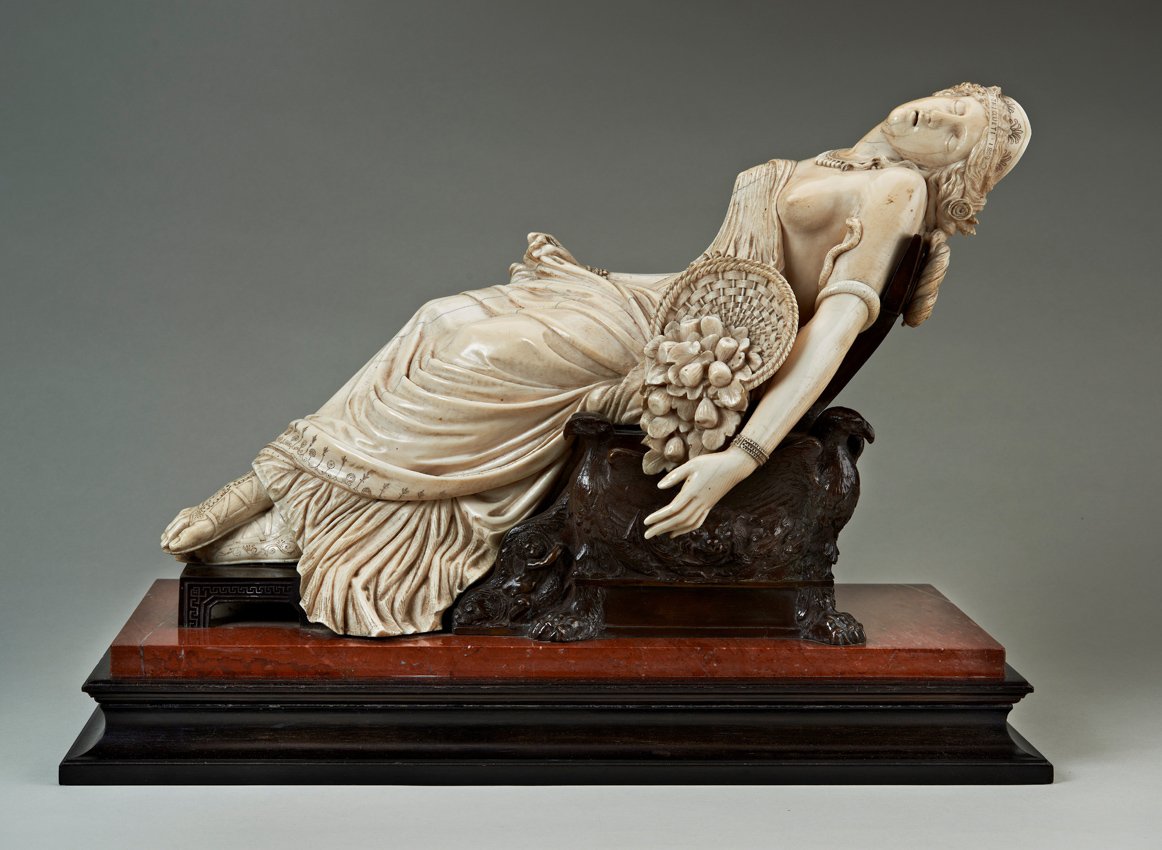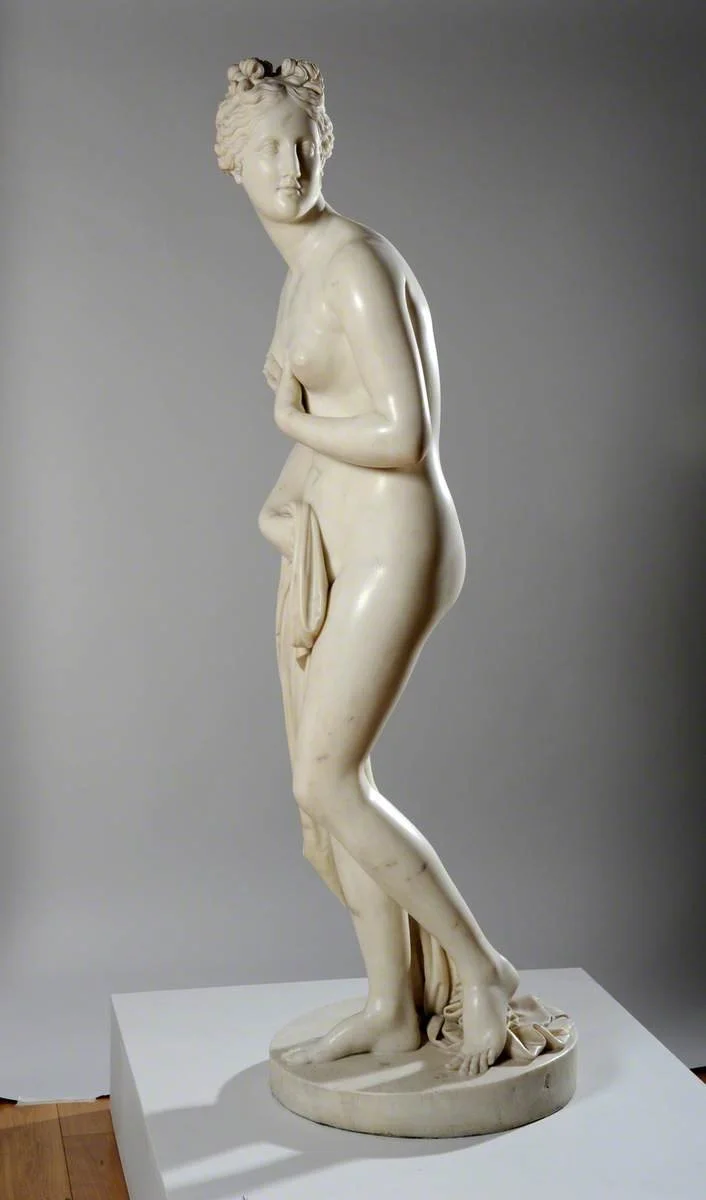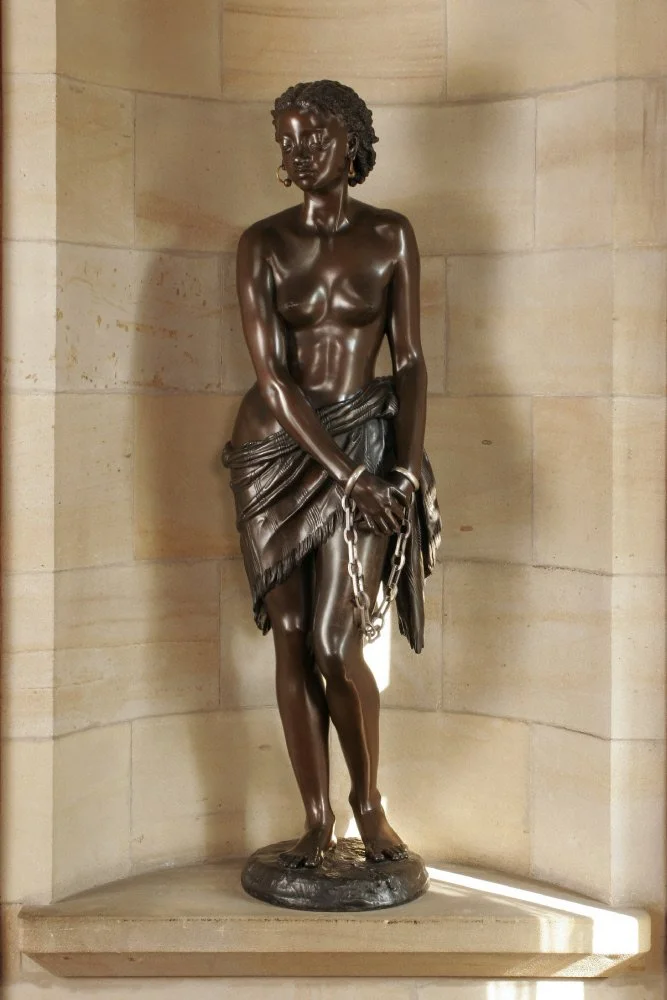The Colour of Anxiety: January Pick of the Month
BY DR NICOLA JENNINGS
The Colour of Anxiety: Race, Sexuality and Disorder in Victorian Sculpture has been open at Henry Moore Institute in Leeds since November. To start off the new year 2023, we thought we would take a closer look at the exhibition, which was curated by myself (Director of Athena Art Foundation) and Dr Adrienne L. Childs (Adjunct Curator at the Phillips Collection, Washington D.C. and independent scholar). We wanted to look at why British sculptors in the second half of the nineteenth century started to move away from the whiteness of Neoclassical marble and incorporated colour by using bronze, silver, gold and ivory, as well as semi-precious stones, tinted waxes, enamels and paint. The adoption of these materials has typically been attributed to a renewed interest in medieval history and craftsmanship, and to the discovery that ancient Greek sculptures were originally polychromed. New industrial processes also played a significant role in the shift towards colour in sculpture. However, the impact of profound social change, scientific advances such as Charles Darwin’s theory of evolution, and anxieties about race and Empire has received less attention. In the exhibition, we look at how sculptors, most of whom were male, reflected these anxieties in their conception of white and Black women’s bodies, reinforcing them with increasingly sexualized and coloured imagery.
G.F. Watts’ Found Drowned, 1848-50 (Image courtesy of the Henry Moore Institute)
The first gallery FROM THE HOPE VENUS TO THE TINTED VENUS introduces visitors to the Victorian ideals of female chastity, purity and motherhood, as exemplified with two figures in white marble: Antonio Canova’s Venus (The Hope Venus, 1817–20, see below) and The Mother (Woman and Child, 1860–1910) attributed to Raffaelle Monti. Absence of colour was a key characteristic of Neoclassical sculpture; it was intended to act as a sign of a civilisation capable of abstract thought and moral rectitude. Next to these sculptures is G.F. Watts’ Found Drowned (1848–50) about a young woman who has taken her own life and a warning about the consequences of moral weakness.
Also in the room is a vitrine displaying a Punch cartoon entitled “Is Man But a Worm”, criticising Charles Darwin’s theories of natural selection and evolution. These theories were soon translated into the unscientific and alarmist notions of ‘survival of the fittest’ and ‘degeneration’. The education of women and the imagined threat posed by the so-called ‘Orient’ - a place that was believed to be full of barbarism and unbridled sexuality - further challenged the ideal of female chastity. In the centre of the gallery is Hiram Powers’ Greek Slave (1844, see below) depicting a white woman sold into slavery by the Ottomans, which became one of the most widely reproduced sculptures of the nineteenth century. Many viewers understood this work to be an abolitionist statement that indirectly indicted American slavery, while others considered the depiction of a white slave by an American sculptor as a deliberate dismissal of the problem of African American enslavement. Even the celebrated African American abolitionist Frederick Douglass (c. 1818–95) owned a ceramic replica of The Greek Slave.
Canova’s The Hope Venus, 1817-20 (Image: artuk.org)
Hiram Powers’ Greek Slave, 1844 (image courtesy of the Henry Moore Institute)
John Gibson’s Tinted Venus, 1851-56 (Image courtesy of Henry Moore Institute)
In his book Le Jupiter Olympien (1814), French archaeologist Antoine-Chrystome Quatremère de Quincy (1755–1849) had challenged the belief that ancient Greek sculpture was not coloured. However, it took several decades for this theory to gain widespread recognition. John Gibson was one of the first British sculptors to incorporate colour on an otherwise neo-Classical figure, using tinted waxes on the surface of his marble Tinted Venus (1851–56, see above). Although the work itself could not travel to the exhibition in Leeds, Gibson’s tinted maquette (a sculptor's small preliminary model or sketch) and a photograph of it in the Great Exhibition of 1862 hints at its game-changing nature. Even if Gibson’s fellow sculptors were outraged, the public loved the lifelikeness of the goddess’s ivory-tinted skin, blue eyes and rosy lips. Despite their reputation for prudery, Victorians were avid consumers of sculptural nudes. Around the same time, French works such as Henri Baron de Triqueti’s Cleopatra Dying (1859, see below) - resurrecting the ancient chryselephantine technique combining gold and ivory - were beginning to be bought by British collectors. They typified not only the taste for coloured materials but also the late Victorian fascination for all things Egyptian. Colour also played a central role in occultism and Theosophy; both hugely popular and partly based on Egyptian magic.
Henri Baron de Triqueti’s Cleopatra Dying, 1859 (Image courtesy of the Henry Moore Institute)
The exhibition’s second gallery ECHOES OF SLAVERY demonstrates that even if women of colour were unusual subjects in nineteenth-century sculpture, there were numerous representations of erotically charged and bound slaves, sexualised Venuses, and hybrids of both. The French Charles Cordier, whose spectacular Vénus africaine (1852, see below) and La femme Africaine (1857) are on display, served as the official sculptor of Paris's National History Museum. The American sculptor John Bell (who claimed to be an abolitionist) is represented in the exhibition by two works: a bronze reduction of the monumental naked American Slave (1853) and the white marble Octoroon (1868, see below) depicting a woman whose one eighth percentage of African blood renders her a slave. While Bell did help to bring the pathos of the institution of slavery to public attention, he nonetheless traded on the allure of illicit sexuality born of that same system. As Dr Adrienne Childs notes, using white marble (the traditional medium of Neoclassical sculpture) to represent the Black body created a tension that challenged the material’s association with white Western culture, morality and purity. One approach to resolve these tensions for Victorian artists and viewers was to use coloured materials to depict Black bodies. Once again, these works were extremely popular, scaled down and reproduced in bronze, plaster, porcelain and other metals. These reproductions made them accessible to a larger audience but also turned them into commodities, with the image of the enslaved woman as a luxury object echoing the practice of slavery itself.
The room also features American contemporary artist Sanford Biggers’ Nile which fuses classical African and European sculpture to create a hybrid work, and Calliope (1989) by the Scottish-Ghanian Maud Sulter (1960-2008), one of a cadre of activities who sought in the 1980s to bring attention to the work of marginalized Black artists who were women. Calliope was the Greek muse of poetry, but Sulter’s photochrome is also a self-portrait that draws upon photographer Félix Nadar’s photograph of poet Charles Baudelaire’s muse and mistress Jeanne Duval.
John Bell’s American Slave, 1853 (Cragside © National Trust / Andrew McGregor)
Charles Cordier’s Vénus africaine, 1852 (Image courtesy of the Henry Moore Institute)
John Bells’s Octoroon, 1868 (Image courtesy of the Henry Moore Institute)
The final gallery of the exhibition is DEATHLY WOMEN, featuring some of the many femme fatales and sleeping women in late Victorian sculpture. Harry Bates’ Pandora (1890, see below) was the first British sculpture to employ the chryselephantine technique to draw attention to evil that this mythical woman had unleashed upon the world. Sir George Frampton used ivory, bronze, opals and glass to create his serpentine temptress Lamia (1899–1900). The painter Ernest Normand’s Pygmalion and Galatea 1881 captures the moment when the white stone flushes with colour as the goddess Venus grants Pygmalion’s wish to bring Galatea to life. The gallery includes another vitrine, this time with a copy of Bram Stoker’s Dracula (1897) and an illustration from ‘The Sleeping Beauty’, a dark medieval tale retold as ‘Briar Rose’ in the popular Grimm’s Fairy Tales (first published in 1812). Inspired by Edward Burne-Jones’ series The Legend of the Briar Rose, the sculptor Sir Alfred Gilbert encircled his Virgin and Saint Elizabeth 1899 with pink rose briar on his tomb for the Duke of Clarence (1864–92) at Windsor Castle, depicting the women as if in the sleep of eternal maidenhood. Harry Bates’ Mors Janua Vitae (1899, see below) is also chryselephantine and produced in the final months before his death, and features another woman with her eyes closed. She represents Life but is about to be engulfed by the dark wings of the male figure of Death. They stand on a sphere depicting a Christian Last Judgement and imagery from ancient Greek myths about death.
Harry Bates’ Pandora, 1890 (Image courtesy of the Henry Moore Institute)
Harry Bates’ Mors Janua Vitae, 1899 (Image courtesy of the Henry Moore Institute)
If you’ve enjoyed this article, then check out Athena Art Foundation’s recent podcast episode about the exhibition, featuring Dr Adrienne Childs in conversation with two scholars of 19th-century sculpture, Dr Caitlin Beach and Dr Mia L. Bagneris.
January 2023













